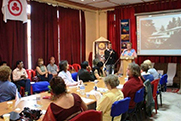
|

|
On April 29, 2018, within the framework of the Spring Roerich Culture Festival «The Roerichs’ Himalayan Estate – Karma-Bhumi of the Great Russian Family» the International Roerich Memorial Trust (IRMT), Naggar held an international academic seminar «The Roerichs in Kullu: Aspects of Creativity». It was dedicated to the multifaceted work of Nicholas and Helena Roerich, and their sons, George and Svetoslav Roerich during their protracted stay in the Kullu valley (1928-1947). The seminar was chaired by the Deputy Head of the United Center for the Problems of Cosmic Thinking, ICR, Moscow Mr. Anatoly Lebedenko.
On behalf of the Embassy of the Russian Federation in the Republic of India the participants of the seminar were welcomed by Ms. Evgeniya Zeegofer, Second Secretary (Culture).
Dr. Saurabh Naik, Assistant Professor, Department of Slavonic and Finno-Ugrian Studies, University of Delhi, presented a general overview of the philosophical teaching of the Agni Yoga (Living Ethics) that the Roerichs developed in cooperation with the Indian spiritual Masters, the Mahatmas. He stressed its relevance in contemporary world and its applicability in daily life. Dr. Naik’s paper was a commendable and valuable example of Indian academia’s turning to the Roerichs’ philosophical legacy and making it an object of scientific investigation.
Mrs. Natalia Cherkashina, Acting Director, Non-Governmental Museum of Nicholas Roerich, ICR, Moscow demonstrated in her presentation that the philosophical system of the Living Ethics was one of the most significant sources of inspiration and creativity of the Roerichs. The scientific and artistic goals of the Roerich Central Asian Expedition were connected with the ideas of the evolution of mankind propounded in the Living Ethics; the Living Ethics’ thesis that culture is the foundation of that evolution became the basis of the Roerich Pact; and the Living Ethics as a new cognitive system determined the objectives and structure of ‘Urusvati’ Himalayan Research Institute. Nicholas Roerich himself called his paintings the «Art Commentary» on the Living Ethics. They are an artistic reflection of the ideas of this philosophical system and carry within themselves the Knowledge and Beauty without which our evolutionary progress is inconceivable.
Mr. Vassily Tkachev, researcher and member of the group of the ICR volunteers, presented his paper titled The Roerich Pact: Pages of History.He traced the history of the Roerich Pact from the very inception of Nicholas Roerich’s idea of the necessity of protection of cultural heritage to its signing in 1935. He talked of the three conferences in support of the Pact, formation of various international public bodies for the promotion of the Pact and the coordinating and leading role Nicholas Roerich played in bringing the first ever international treaty for the protection of historic monuments to its consummation. He remarked that India was one of the first countries to support the idea of the Pact in India and stressed the important role the Pact plays in the spiritual evolution of mankind.
Speaking on ‘Urusvati’ Himalayan Research Institute: Collaboration with World-Renowned Scholars, Mr. Anatoly Lebedenko, Deputy Head, United Center for the Problems of Cosmic Thinking, ICR, Moscow, familiarized the participants of the seminar with the structure of the Institute and spoke of its methodology based on the evolutionary synthesis of knowledge. The Institute actively cooperated with various scientific and cultural institutions the world over, as well as with renowned scholars, including Indian, such as physicist Chandrasekhara Venkata Raman and biophysicist Jagadish Chandra Bose. He also focused on the vision of the Roerichs to transform the Institute into the international “City of Knowledge” based on cooperation and representing the synthesis of all branches of contemporary science.
In his video presentation The Summer Station of ‘Urusvati’ Himalayan Research Institute in Lahaul the Estonian researcher Mr. Sergey Yakovlev told the gathering about the diverse activities undertaken by the Roerichs during their field trips in Lahaul in 1929-1932. He showed the rare archival photographs taken by the Roerichs in that remote Himalayan region and quoted related passages from Nicholas Roerich’s diary. ‘Urusvati’ Himalayan Research Institute had a summer station in Gungshal village in the vicinity of Keylong, and the Roerichs visiting the place in July-September actively explored the nature and culture of Lahaul and neighbouring areas.
The practicing physician, human electromagnetic fields researcher Mrs. Marina Tarasova (Kurgan, Russia) explored in her paper titled Helena Roerich on the New Fields of Research. The Kirlian Effect as a New Field of Modern Science. Making use of a wide selection of slides, she demonstrated the famous Kirlian Effect (also known as high voltage photography or gas discharge visualization) named after the Russian scientists Mr. and Mrs. Kirlian. This discovery was a real breakthrough in the studies of subtle energies and human energy-information emanations that Helena Roerich anticipated in her writings already in 1930s. At present, the Kirlian Method is widely used in medicine, psychology, sport, agriculture, metallurgy, in the studies of human compatibility and the influence of art on man.
The seminar that brought together Russian and Indian scholars and researchers became one more contribution to the studies of the multifaceted creativity of the Roerichs and, therefore, one more step towards the revival of ‘Urusvati Himalayan Research Institute founded by them.
Read also the ICR site
|


